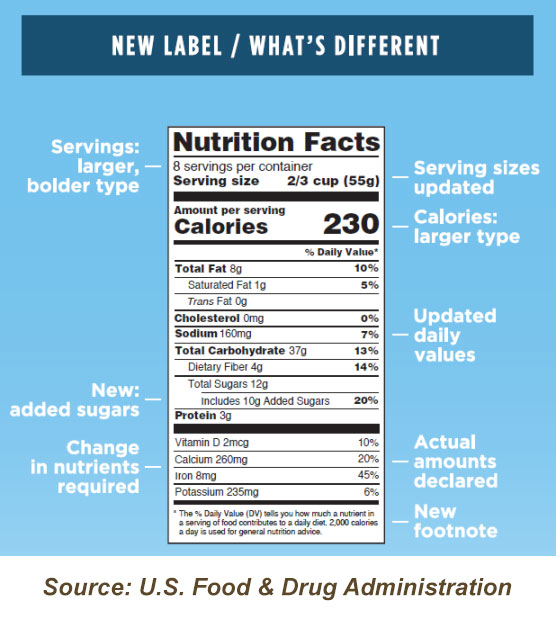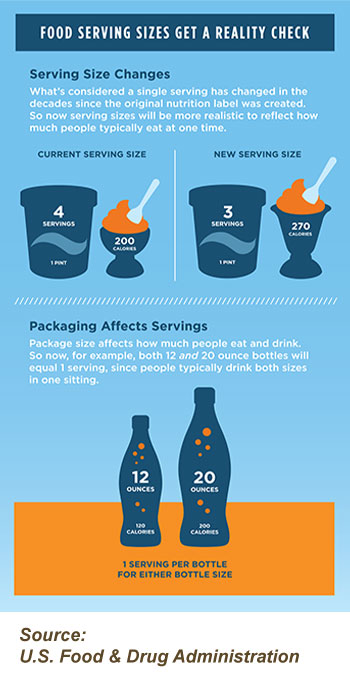Recent changes to food labels can help families make healthier
choices at the grocery store. The Nutrition Facts label on packaged foods and beverages is now easier to read and understand. It also includes more information on nutrients most U.S. children and adults get too much or too little of in their diets. The changes are based on new findings about diet-related health problems that affect growing numbers of children and adults.

Do all foods have the new label now?
Most, but not all, products do. The U.S. Food and Drug Administration (FDA) required most packaged foods and beverages made by large companies to start using the
new label as of January 2020.
What is different on the new label?
Here are 8 key changes on the new Nutrition Facts label that help families know if products they buy measure up with dietary needs.
Calories & Serving Size. The new Nutrition Facts has larger, bolder letters for "Calories," as well as “servings per container," and "Serving size." Serving sizes on the new label now more closely reflect how much people today actually eat and drink (though not necessarily how much they should eat). For example, the reference amount used to set a serving of ice cream was previously ½ cup but is changing to ⅔ cup.
Two-Column Labels. The new FDA rules also require two-column labels on packages that contain between one and two servings, because people typically will consume these in one sitting. On these products, one column now lists calorie and nutrition information for the average serving size, and one for the entire package. A 12-ounce or 20-ounce bottle of
soda will be labeled as 1 serving, for example, since people are likely to drink either size at one time.
 Added sugars. For the first time, the Nutrition Facts label includes the amount of
added sugars each serving of the product has. Eating and drinking too many foods and beverages with added sugars is tied to chronic diseases such as
obesity,
diabetes and
heart disease. With rates of these diseases in children and adults on the rise, the Academy of Pediatrics, the American Heart Association and other major health groups
call for limiting added sugars in the diet.
Added sugars. For the first time, the Nutrition Facts label includes the amount of
added sugars each serving of the product has. Eating and drinking too many foods and beverages with added sugars is tied to chronic diseases such as
obesity,
diabetes and
heart disease. With rates of these diseases in children and adults on the rise, the Academy of Pediatrics, the American Heart Association and other major health groups
call for limiting added sugars in the diet.
The two main sources of added sugars in the U.S. diet are sugar-sweetened beverages (including soda,
sport and energy drinks and
fruit drinks) and
snacks and sweets.
Fiber. The recommended Daily Value of dietary
fiber, which many Americans fall short of, increased from 25 to 28 percent of total calories. The change reflects growing research that shows how important fiber is to healthy digestion, heart health, and body weight.
Fats. The Nutrition Facts label no longer list the percentage of “calories from fat" and instead will show percentages from just the unhealthy saturated and
trans fats. When it comes to health outcomes, the type of fat you eat matters more than the overall amount of fat.
Vitamin D. The daily values per serving for
Vitamin D is now included, since Americans don't always get enough of this nutrient. Vitamin D helps keep bones, muscles, nerves and the immune system strong and healthy.
Sodium & potassium. Most Americans consume too much
sodium and not enough
potassium, both of which can contribute to high blood pressure. The new food label slightly lowered the daily limit for sodium from 2,400 mg per day to 2,300 mg per day, and now also requires potassium content to be listed.
Vitamin A & C. The amount of vitamins A and C will no longer need to be listed on the label, but may still be included on a voluntary basis. Deficiencies of these nutrients no longer common, like they were when the Nutrition Facts label was first created.
Remember
If you have questions about choosing healthy, nutritious foods for your child, talk with your pediatrician.
More Information